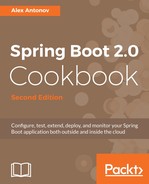You will see the Project Dependencies section, where we can choose the kind of functionalities that our application will perform: Will it connect to a database? Will it have a web interface? Do we plan to integrate with any of the social networks bake in operational support? and so on. By selecting the desired technologies, the appropriate starter libraries will be added automatically to the dependency list of our pregenerated project template.
Before we proceed with the generation of our project, let's go over what exactly a Spring Boot starter is and the benefits it provides us with.
Spring Boot aims to make it easy to get started with creating an application. Spring Boot starters are bootstrap libraries that contain a collection of all the relevant transitive dependencies that are needed to start a particular functionality. Each starter has a special file, which contains the list of all the provided dependencies Spring provides. Let's take a look at the following link for a spring-boot-starter-test definition as an example:
https://github.com/spring-projects/spring-boot/blob/master/spring-boot-project/spring-boot-starters/spring-boot-starter-test/src/main/resources/META-INF/spring.provides
Here we will see the following code:
provides: spring-test, spring-boot, junit, mockito, hamcrest-library, jsonassert, json-path
This tells us that by including spring-boot-starter-test in our build as a dependency, we will automatically get spring-test, spring-boot, junit, mockito, hamcrest-library,jsonassert, and json-path. These libraries will provide us with all the necessary things in order to start writing application tests for the software that we will develop, without needing to manually add these dependencies to the build file individually.
With more than 100 starters provided, and with the ongoing community additions increasing the list, it is very likely that unless, we find ourselves with the need to integrate with a fairly common or popular framework, there is already a starter out there that we can use.
The following table shows you the most notable ones so as to give you an idea of what is available:
|
Starter |
Description |
|
spring-boot-starter |
This is the core Spring Boot starter that provides you with all the foundational functionalities. It is depended upon by all other starters, so no need to declare it explicitly. |
|
spring-boot-starter-actuator |
This starter provides you with a functionality to monitor, manage an application, and audit. |
|
spring-boot-starter-jdbc |
This starter provides you with a support to connect and use JDBC databases, connection pools, and so on. |
|
spring-boot-starter-data-jpa spring-boot-starter-data-* |
The JPA starter provides you with needed libraries so you can use Java Persistence API (JPA): Hibernate, and others. Various data-* family starters provide support for a number of datastores, such as MongoDB, Data REST, or Solr. |
|
spring-boot-starter-security |
This brings in all the needed dependencies for Spring Security. |
|
spring-boot-starter-social-* |
This allows you to integrate with Facebook, Twitter, and LinkedIn. |
|
spring-boot-starter-test |
This is a starter that contains the dependencies for spring-test and assorted testing frameworks: JUnit and Mockito, among others. |
|
spring-boot-starter-web |
This gives you all the needed dependencies for web application development. It can be enhanced with spring-boot-starter-hateoas, spring-boot-starter-websocket, spring-boot-starter-mobile, or spring-boot-starter-ws, and assorted template-rendering starters: sping-boot-starter-thymeleaf or spring-boot-starter-mustache. |
|
spring-cloud-starter-* |
Various cloud-* family starters providing support for a number of frameworks, such as Netflix OSS, Consul, or AWS. |
